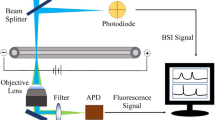Abstract
A faster and more convenient method is required for the detection of recombinant erythropoietin (Epo) in human body fluids. In the present study we wanted to elucidate the principal suitability of immunoaffinity capillary electrophoresis (CE) in this respect. CE offers itself as a high-speed, high-throughput technique provided a suitable affinity reagent is available. We chose monoclonal antibody 5F12 from Amgen which binds to a conformation-independent epitope in the N-terminal region of the human Epo protein. For CE with laser-induced fluorescence detection it was necessary to produce fluorescently labelled antibody with one single antigen binding site. Monomeric antigen-binding fragments (Fab) were obtained by site-selective cleavage of the pure antibody and labelled with the fluorescent dye, Alexa Fluor 488. The mixture of labelled isomers was partially resolved by ion exchange HPLC and isoelectric focusing. The fluorescent Fab could be used to detect erythropoietin by immunoaffinity capillary isoelectric focusing and zone capillary electrophoresis via its antigen complex.





Similar content being viewed by others
Abbreviations
- BGE:
-
background electrolyte
- CE:
-
capillary electrophoresis
- Epo:
-
Erythropoietin
- Fab:
-
antigen-binding fragment
- FITC:
-
fluorescein isothiocyanate
- IEF:
-
isoelectric focusing
- mAb:
-
monoclonal antibody
- PBS:
-
phosphate-buffered saline
- rHuEpo:
-
recombinant human erythropoietin
- scFv:
-
(recombinant) single chain variable fragment
- SDS-PAGE:
-
denaturing polyacrylamide gel electrophoresis in the presence of sodium dodecyl sulfate
- ECL:
-
enzyme-coupled chemoluminescence
- vH :
-
variable domain
- cH1–3 :
-
constant domains of an antibody's heavy chain
References
Choi D, Kim M, Park J (1996) J Chrom B 687:189–199
Schänzer W (2000) Dt Zeitschr Sportmed 51:260–266
Wide L, Bengtsson C, Berglund B, Ekblom B (1995) Med Sci Sports Exerc 27:1569–1576; Berglund B, Wide L (2002) Scand J Med Sci Sports 12:354–357
Lasne F, de Ceaurriz J (2000) Nature 405:635
Watson E, Yao F (1993) Anal Biochem 210:389–393
Kubach J, Grimm R (1996) J Chrom A 737:281–289
Lopez-Soto-Yarritu P, Díez-Masa JC, Cifuentes A, de Frutos M (2002) J Chrom A 968:221–228
Schultz NM, Tao L, Rose DJ, Kennedy RT (1997) In Landers JP (ed) Handbook of capillary electrophoresis, 2nd edn. CRC Press Boca Raton
Perrett D (1998) In Camillieri P (ed) Capillary electrophoresis. CRC Press Boca Raton
Schmalzing D, Buonocore S, Piggee C (2000) Electrophoresis 21:3919–3930
Elliott S, Chang D, Delorme E, Dunn C, Egrie J, Griffin J, Lorenzini T, Talbot C, Hesterberg L (1996) Blood 87:2714–2722
Elliott S, Lorenzini T, Chang D, Barzilay J, Delorme E, Griffin J, Hesterberg L (1996) Blood 87:2702–2713
Cheetham JC, Smith DM, Aoki KH, Stevenson JL, Hoeffel TJ, Syed RS, Egrie J, Harvey TS (1998) Nature Struc Biol 5:861–866
Bradford MM (1976) Anal Biochem 72:248–254
Laemmli UK (1970) Nature 227:680–685
Smith TK, Meister A (1995) J Biol Chem 270:12476–12480
Gilbert HF (1995) Methods Enzymol 251:8–28
Righetti PG (2000) HPCE conference Saarbrücken
Egrie J (1985) US patent 4 558 006
Haugland RP (2001) Handbook of fluorescent probes and research products, 8th edn. Molecular Probes Eugene
Shimura K, Karger BL (1994) Anal Chem 66:9–15
Chen FTA (1994) J Chrom A 680:419–423
Kortt AA, Dolezal O, Power BE, Hudson PJ (2001) Biomol Eng 18:95–108
http://www.clontech.com/products/literature/pdf/brochures/LivingColors.pdf. Cited 13 Jan 2003
Acknowledgements
This work was supported by a grant from the German Federal Government (BMBF Schwerpunktprogramm Glykobiotechnologie). We thank F. Hoffmann-La Roche AG for a generous gift of recombinant human erythropoietin and Dr Stefan Müller for inspiring discussion. Peptide synthesis was performed by the ZMMK service lab, University at Cologne. Michael Kolloch and Ulrich Kutscher analysed and purified APP20.
Author information
Authors and Affiliations
Corresponding author
Rights and permissions
About this article
Cite this article
Bornemann, C., Burggraef, T., Heimbüchel, G. et al. Fluorescence-labelled antigen-binding fragments (Fab) from monoclonal antibody 5F12 detect human erythropoietin in immunoaffinity capillary electrophoresis. Anal Bioanal Chem 376, 1074–1080 (2003). https://doi.org/10.1007/s00216-003-2038-3
Received:
Revised:
Accepted:
Published:
Issue Date:
DOI: https://doi.org/10.1007/s00216-003-2038-3




